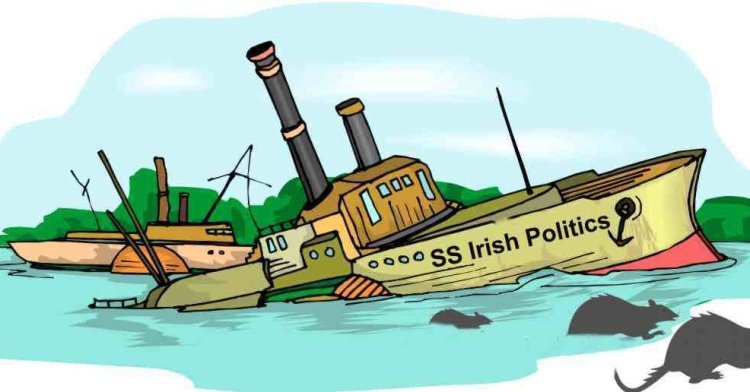However, the new governmental coalition of Fine Gael (FG), a Christian Democratic Party in the EPP, and the social-democratic Labour Party in S&D changed very few of the austerity policies pursued by Fianna Fáil in their dying days in office, resulting in the government, and Labour in particular, becoming deeply unpopular, and seeing the nationalist and far-left Sinn Fein (SF) in EUL, untainted by government, grow enormously in the polls.
Since that election Irish politics has changed dramatically. With national politics in such flux, it came as little surprise that the elections to Europe were unpredictable. Ireland only returns eleven MEPs from three constituencies, with three returned from Dublin and four each from the vast rural constituencies of South and Midlands-North-West (the latter is larger than Belgium), whose boundary essentially dissects the country in a horizontal line from Dublin. All three of the main parties – FF, FG and Labour – had reason to be fearful of this change. Due to defection and retirement, the abolition of the old East constituency effectively reduced the number of potential seats for each party by one. By contrast, the new four-seater rural constituencies increased opportunities for small parties and independents.
Much like many of its counterparts across Europe, the European Elections in Ireland saw a strong rebuke of ‘mainstream’ pro-European parties. Unlike many of its counterparts across Europe, Ireland did not see a new party sweep up discontent. Rather Ireland saw an extremely strong vote for independent candidates, who performed exceptionally well.
Ireland has a long history of electing independent deputies – and there are usually more independent deputies in the national parliament than there are in the parliaments of every other member state in the EU put together. This is usually attributed to single-transferable vote electoral prioritising candidate over party. Europe is no exception to this trend. Past independents elected to the Europe include Dana Rosemary Scallon, a former Eurovision winner, as well as less exciting (but probably more effective) candidates like Pat Cox, who became President of the European Parliament in addition to leader of ALDE, and T.J. Maher, a former leader of the National Farmers Federation. However, the only independent MEP elected in 2009 was Marian Harkin, a moderate pro-European who sits with ALDE. This means that, with the exception of Socialist MEP Paul Murphy, every outgoing Irish MEP was broadly pro-Europe (although none of them, or any candidate in Ireland, was a confirmed federalist).
These elections were considered exceptionally unpredictable, with polls showing seven competitive candidates for three seats in Dublin alone, and the others scarcely less competitive. However they all agreed on one thing – the mainstream would do very badly. The results confirmed this. Labour was expected not to win a seat, and came nowhere close to one – leaving S&D without an MEP from every member state. Fianna Fáil – more surprisingly – polled the numbers of nightmares. In spite of coming first nationally they only delivered one seat for ALDE – the socially conservative Brian Crowley – with group leader Pat ‘the Cope’ Gallagher being defeated. Fine Gael by contrast won four seats with slightly fewer votes.
The winners? Sinn Fein will undoubtedly be pleased. In spite of nominating almost total unknowns all three of their candidates won with ease. All three are young, articulate and are very far removed from the shadow of IRA gunmen. However the big surprises of the election were the performance of two independent candidates – Nessa Childers in Dublin and Luke ‘Ming’ Flanagan in Midlands-North-West.
Childers has had a remarkably varied political career. The daughter of a FF president, she was elected as a Green candidate in the local elections in Dublin in 2004, before resigning her seat. She was then tapped by Labour and was elected in the old East constituency as an MEP. She subsequently left Labour and was expelled from S&D and decided to run in Dublin for re-election – the only constituency that contained none of her old constituency or electorate! In spite of this and the lack of any organisation she polled well, and actually won the second Dublin seat.
Luke ‘Ming’ Flanagan is even more unusual. An independent deputy in parliament, he acquired his nickname due to his apparent resemblance to the super-villain Ming the Merciless, and is known for his passionate advocation for the legalisation of cannabis, which, by his own admission at the time of his election, he used regularly (in spite of this being illegal).His running for a European seat was considered a surprise, and his campaign has focused on two things – his opposition to an apparent ban on cutting turf from bogs for fuel (a rather niche issue one would have thought), and euroscepticism. He was elected easily, showing that euroscepticism can win elections in Ireland even without a party logo to help the candidate – a worrying development. This means that Ireland’s traditional parties only elected five MEPs – four FG and one FF – against six outsiders – three SF and three independents (with the former and one of the latter being eurosceptics). A political earthquake indeed.

Follow the comments: |
|
